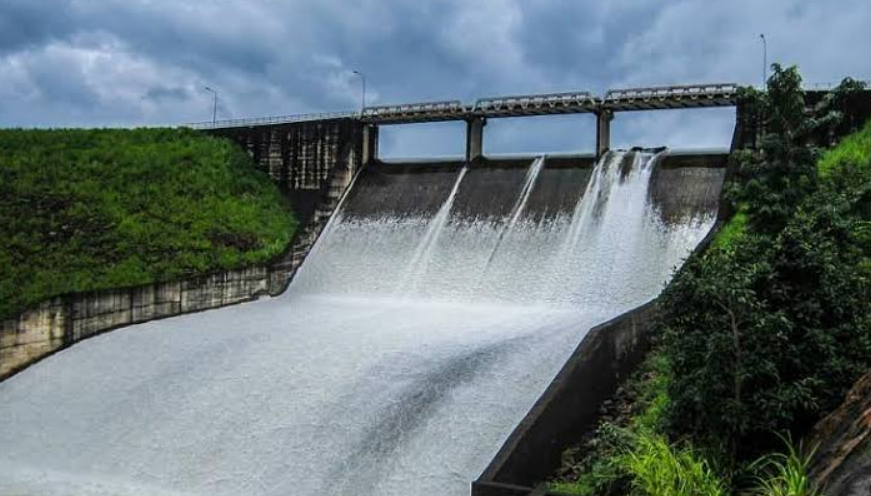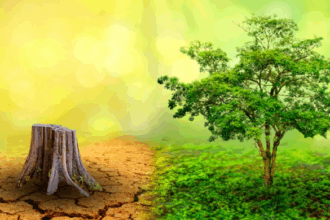Water is one of the most essential natural resources for all life forms on Earth. Although our planet is covered with water, only a small portion is available as freshwater for human use. India faces a serious challenge of uneven water distribution, over-exploitation of groundwater, increasing population, and rising demand from agriculture and industries. As a result, many regions experience water scarcity. To ensure sustainable development, it becomes necessary to conserve, manage, and use water resources wisely through traditional practices, modern technologies, and community participation.
Introduction
- Water is an essential resource for all forms of life — humans, animals, and plants depend on it.
- India has a huge amount of water, but it is not evenly distributed across the country.
- Some regions face water scarcity, while others get excess rainfall leading to floods.
The world’s freshwater is very limited —
- 97% of water is in oceans (salty),
- only 3% is freshwater.
- Out of this 3%, most freshwater is locked in glaciers and ice caps.
- Only a very small portion is available for human use (in rivers, lakes, groundwater).
- Due to growing population, agriculture, industries, and urbanisation, the demand for water is rising quickly.
Overuse and misuse of water are creating serious problems like:
- Water shortage
- Falling groundwater levels
- Pollution of water bodies
Therefore, water conservation and management have become important for sustainable development.
Topic-1: Water Scarcity
- Water scarcity means lack of enough water to meet the needs of people, agriculture, and industries.
- It is not only due to less rainfall, but also because of:
1. Overpopulation
- More people = more demand for drinking water, domestic use, and sanitation.
2. Increasing Agriculture
- India uses a large amount of water for irrigation.
- Commercial farming and water-intensive crops (sugarcane, rice) use huge amounts of water.
- Overuse of groundwater for irrigation leads to water scarcity.
3. Industrial Growth
- Factories require a lot of water for cooling, processing, and cleaning.
- Many industries pollute rivers and lakes, making water unfit for use.
4. Uneven Distribution of Rainfall
- Some regions get very little rainfall (e.g., Rajasthan).
- Other areas get rain only during monsoon, leading to seasonal shortages.
5. Poor Water Management
- Leakage in pipelines
- Wastage of water
- Lack of proper storage systems
6. Over-exploitation of Groundwater
- Excessive use of borewells and tubewells lowers the water table.
7. Water Pollution
- Domestic sewage, industrial waste, pesticides, and plastics pollute water sources.
- Polluted water becomes unsafe and increases scarcity.
Topic-2: Need for Water Conservation and Management
1. Limited Availability of Freshwater
- Only a small portion of Earth’s water is available for human use.
- Increasing demand and limited supply make conservation necessary.
2. Rising Population
- More people = more water required for drinking, cooking, cleaning, and sanitation.
- Without proper management, demand will exceed supply.
3. Over-exploitation of Water Resources
- Excessive use of groundwater through borewells is lowering the water table.
- Some areas are facing severe water shortage due to overuse.
4. Urbanisation and Industrialisation
- Growing cities and industries need huge amounts of water.
- Industries also polTlute water bodies, reducing usable water.
5. Agricultural Needs
- Agriculture is the largest consumer of water in India.
- Traditional methods waste a lot of water.
- Efficient irrigation methods like drip and sprinkler systems are needed.
6. Uneven Distribution of Rainfall
- Some regions receive very high rainfall, while others remain dry.
- Proper storage and management can reduce flood and drought risks.
7. Climate Change
- Changing rainfall patterns and melting glaciers are affecting water availability.
- Conservation can help us prepare for future uncertainties.
8. Preventing Water Pollution
- Polluted water from industries, households, and chemicals becomes unusable.
- Conservation includes keeping rivers, lakes, and ponds clean.
9. Protecting Ecosystems
- Rivers, lakes, wetlands, and forests depend on water.
- Conserving water helps maintain natural ecosystems and biodiversity.
10. Sustainable Development
- Future generations also need water.
- Saving and managing water ensures long-term development.
Topic-3: Multipurpose River Projects
1. Meaning
- Large dams built on rivers to serve many purposes at the same time.
- They help in controlling floods, producing electricity, supplying water, etc.
2. Main Objectives
- Irrigation – Water stored in dams is used to irrigate farmlands.
- Hydroelectric Power (HEP) – Dams generate electricity without pollution.
- Flood Control – Extra water is stored to prevent floods.
- Water Supply – Provides drinking water to cities and industries.
- Navigation – Helps boats and ships travel easily.
- Recreation – Dams create lakes for tourism, fishing, and boating.
- Soil Conservation – Reduces soil erosion by controlling water flow.
3. Examples of Multipurpose Projects
- Bhakra Nangal Dam – Satluj River
- Hirakud Dam – Mahanadi River
- Damodar Valley Project – Damodar River
- Tehri Dam – Bhagirathi River
- Sardar Sarovar Dam – Narmada River
Problems and Concerns of Multipurpose Projects
- Displacement of people from dam areas.
- Loss of biodiversity due to submerged forests.
- High cost of construction and long time to build.
- Social conflicts over sharing water.
- Environmental issues like earthquakes and silting of reservoirs.
Topic-4: Integrated Water Resources Management (IWRM)
1. Meaning
- A method in which water is managed in a coordinated and balanced way, considering:
- People
- Environment
- Economy
It aims to use water efficiently, fairly, and sustainably.
2. Key Features
Drip irrigation, sprinklers, recycling of water, rainwater harvesting, etc.
- Holistic Approach: All uses of water (agriculture, industry, drinking, environment) are managed together.
- Participation of People: Local communities, farmers, NGOs, and governments work together.
- Sustainable Use: Ensures that water is conserved for future generations.
- River Basin Management: Water is planned based on the whole river basin, not just one area.
- Reducing Conflicts: Ensures fair distribution of water among states and communities.
Topic-5: Opposition of Multipurpose River Projects
Multipurpose river projects were built to control floods, provide irrigation, and generate electricity.
But many people and groups oppose them because of their social, economic, and environmental problems.
1. Displacement of People
- Construction of dams floods large areas.
- Thousands of people lose their homes, land, and livelihood.
- Rehabilitation and compensation are often not proper or delayed.
2. Environmental Damage
- Large forests get submerged underwater.
- Wildlife habitats are destroyed.
- River ecosystems are disturbed.
- Fish migration gets affected due to blocked river flow.
3. Increased Social Conflicts
- Conflicts arise between:
- States
- Villagers and government
- Farmers and industries
- People fight over sharing of water and benefits.
4. Floods Instead of Protection
- Dams sometimes increase floods if:
- Water is suddenly released
- Silt fills the reservoir and reduces its capacity
- This creates damage downstream.
5. High Cost of Construction
- Building large dams requires a huge amount of money.
- Maintenance costs are also very high.
- Benefits may take many years to show.
6. Loss of Livelihood
- Farmers, fishers, and tribal communities lose:
- Agricultural land
- Fishing areas
- Forest resources
- Their traditional lifestyle is affected.
7. Earthquake and Safety Concerns
- Large dams can trigger small earthquakes in some regions.
- Dam failure due to heavy rainfall or poor construction can be dangerous.
8. Criticism from Environmental Movements
Many social and environmental groups oppose these projects, such as:
- Narmada Bachao Andolan
- Tehri Dam Movement
They demand sustainable and people-friendly development.
Topic-6: Rainwater Harvesting
1. Meaning
- Rainwater harvesting is the method of collecting and storing rainwater for future use.
- It helps reduce dependence on rivers, lakes, and groundwater.
2. Need for Rainwater Harvesting
- Falling groundwater levels
- Seasonal and uneven rainfall
- Water scarcity in rural and urban areas
- To reduce floods and soil erosion
- To ensure sustainable water supply
3. Traditional Methods of Rainwater Harvesting in India
a) In Himalayan Regions
- Kuhls – Channels that divert water from streams.
b) In Rajasthan
- Tankas – Underground tanks to store drinking water.
- Johads – Small earthen structures to collect runoff water.
- Baoris/Bawdis – Stepwells used for storage.
c) In Maharashtra
- Khatri – Storage in wells and tanks.
d) In Bengal
- Dighis and ponds used for water storage.
4. Modern Methods of Rainwater Harvesting
A. Rooftop Rainwater Harvesting
- Water from rooftops is collected through pipes.
- It is stored in:
- Underground tanks
- Overhead tanks
- Percolation pits to recharge the groundwater
B. Surface Runoff Harvesting
- Collecting rainwater from parks, roads, and open grounds.
- Stored in ponds and reservoirs.
5. Benefits of Rainwater Harvesting
- Recharges groundwater and increases water table.
- Reduces dependence on municipal water supply.
- Prevents floods during heavy rainfall.
- Provides clean water for drinking (after filtering).
- Helps in agriculture and household use.
- Low cost and environment-friendly.
6. Example: Tamil Nadu
- Tamil Nadu is the first state in India to make rainwater harvesting compulsory in all houses.
- This resulted in improved groundwater levels.
Tpoic-7: Rooftop Rainwater Harvesting
1. Meaning
- Rooftop Rainwater Harvesting is a method where rainwater falling on the roof of a building is collected, stored, or used to recharge groundwater.
- It is one of the simplest and most effective rainwater harvesting systems.
2. How It Works
- Rainwater falls on the rooftop.
- It is carried through pipes or gutters.
- The water is filtered to remove dust and impurities.
- It is then:
- Stored in underground or overhead tanks, or
- Allowed to percolate into the ground through recharge pits.
3. Components of the System
- Rooftop catchment surface
- Pipes/gutters
- Filters (gravel, sand, or mesh)
- Storage tanks
- Recharge pits or percolation wells
4. Advantages of Rooftop Rainwater Harvesting
- Raises groundwater level and reduces water scarcity.
- Provides water for drinking (if filtered properly).
- Reduces dependence on municipal supply or tankers.
- Low cost and easy to install.
- Reduces water runoff, flooding, and soil erosion.
- Useful in both urban and rural areas.
5. Example: Success in Tamil Nadu
- Tamil Nadu was the first Indian state to make rooftop rainwater harvesting compulsory for every house.
- As a result, groundwater levels increased significantly.
6. Importance in Cities
- Cities face water shortages due to:
- Overuse of groundwater
- Reduced open spaces
- Concrete surfaces
- Rooftop harvesting helps store rainwater and recharge aquifers in urban areas.
Conclusion
Water is a precious and limited resource that must be used responsibly. The problems of water scarcity, pollution, overuse, and unequal distribution highlight the urgent need for proper water conservation and management. Solutions like rainwater harvesting, multipurpose river projects, watershed development, and community-based initiatives can help protect our water resources. Sustainable use today will ensure that future generations also have access to clean and adequate water.
Detailed notes of other chapters:
Resources and Development: Class-10th Geography Chapter-1 ( Easy NCERT Notes )
Forests and Wildlife Resources: Class-10th Geography Chapter-2 ( Easy NCERT Notes )





